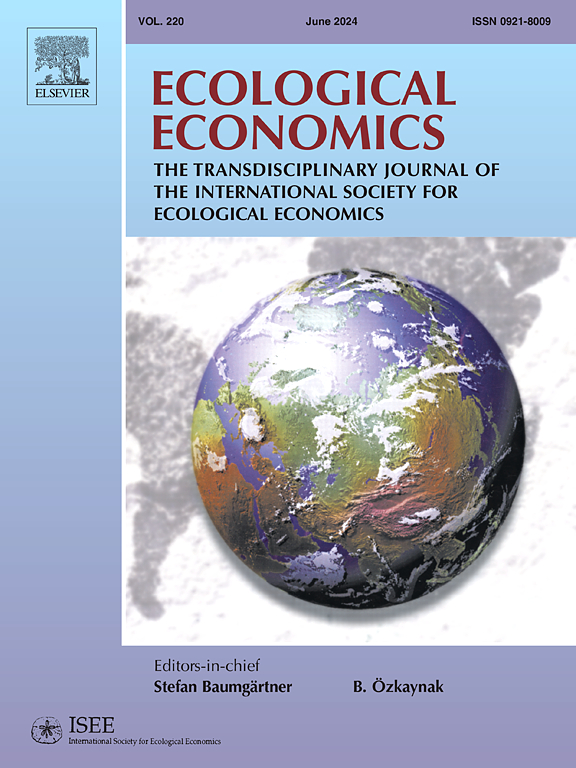德克萨斯州中部土壤健康属性值的离散选择实验估计
IF 6.3
2区 经济学
Q1 ECOLOGY
引用次数: 0
摘要
当农民采用保护性耕作时,他们正在进行一项管理变革,有望改善土壤健康的可管理特征。然而,目前关于土壤健康价值的文献主要集中在土壤固有特征的价值上。在本文中,我们通过估算土壤健康改善的价值来弥补文献中的空白。利用德克萨斯州布拉索斯河流域的农民样本和一个状态偏好离散选择实验,我们得出了农民对改善渗水、表面压实和有机质含量的偏好,这些特征可以通过采用保护性耕作切实改善。我们发现,对于与免耕大致相当的土壤改善,农民平均每年愿意为每英亩支付50-100美元来改善渗水,为减少表面压实支付20-50美元,为每英亩支付2-11美元来改善有机质含量。我们使用人口的子样本、潜在类别规格和混合logit模型来检验偏好异质性,并发现农民的支付意愿存在实质性差异。我们的研究结果为农民对土壤健康的重视提供了见解,但这些价值也有很大的差异,这可能有助于解释为什么土壤保持措施在我们的研究区域没有得到广泛应用。本文章由计算机程序翻译,如有差异,请以英文原文为准。
Discrete choice experiment estimates on the value of soil health attributes in Central Texas
When farmers adopt conservation tillage, they are making a management change that is expected to improve manageable characteristics of soil health. The current literature on the value of soil health, however, primarily focuses on the value of inherent soil characteristics. In this paper we close the gap in the literature by estimating the value of improvements in soil health. Using a sample of farmers in Texas' Brazos River Watershed and a stated-preference discrete-choice experiment, we elicit preferences for improvements in water infiltration, surface compaction, and organic matter content, characteristics that can be realistically improved by adopting a conservation tillage. For soil improvements roughly equivalent to what could be achieved by adopting no-till, we find that, on average, farmers are willing to pay $50–100 per acre per year to improve water infiltration, $20–50 to reduce surface compaction, and $2–11 per acre to improve organic matter content. We examine preference heterogeneity using sub-samples of the population, latent class specifications, and mixed-logit models, and find substantial variation in willingness to pay across farmers. Our findings offer insights into the value farmers place on soil health, but also that there is a great deal of variation in those values, which may help explain why soil conservations practices are not widely used in our study region.
求助全文
通过发布文献求助,成功后即可免费获取论文全文。
去求助
来源期刊

Ecological Economics
环境科学-环境科学
CiteScore
12.00
自引率
5.70%
发文量
313
审稿时长
6 months
期刊介绍:
Ecological Economics is concerned with extending and integrating the understanding of the interfaces and interplay between "nature''s household" (ecosystems) and "humanity''s household" (the economy). Ecological economics is an interdisciplinary field defined by a set of concrete problems or challenges related to governing economic activity in a way that promotes human well-being, sustainability, and justice. The journal thus emphasizes critical work that draws on and integrates elements of ecological science, economics, and the analysis of values, behaviors, cultural practices, institutional structures, and societal dynamics. The journal is transdisciplinary in spirit and methodologically open, drawing on the insights offered by a variety of intellectual traditions, and appealing to a diverse readership.
Specific research areas covered include: valuation of natural resources, sustainable agriculture and development, ecologically integrated technology, integrated ecologic-economic modelling at scales from local to regional to global, implications of thermodynamics for economics and ecology, renewable resource management and conservation, critical assessments of the basic assumptions underlying current economic and ecological paradigms and the implications of alternative assumptions, economic and ecological consequences of genetically engineered organisms, and gene pool inventory and management, alternative principles for valuing natural wealth, integrating natural resources and environmental services into national income and wealth accounts, methods of implementing efficient environmental policies, case studies of economic-ecologic conflict or harmony, etc. New issues in this area are rapidly emerging and will find a ready forum in Ecological Economics.
 求助内容:
求助内容: 应助结果提醒方式:
应助结果提醒方式:


